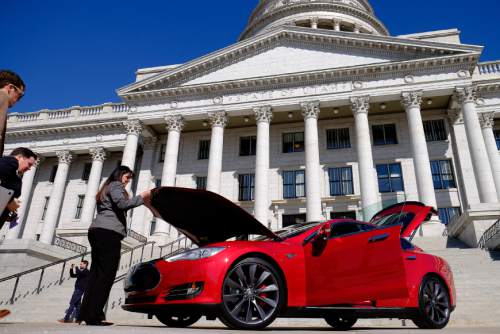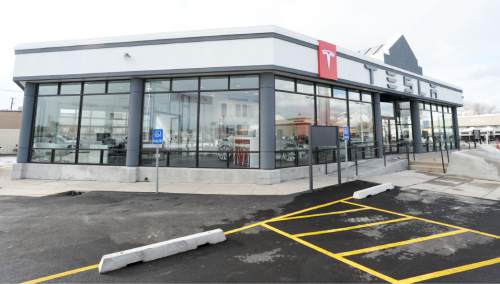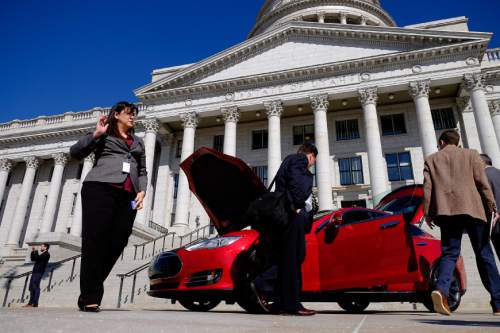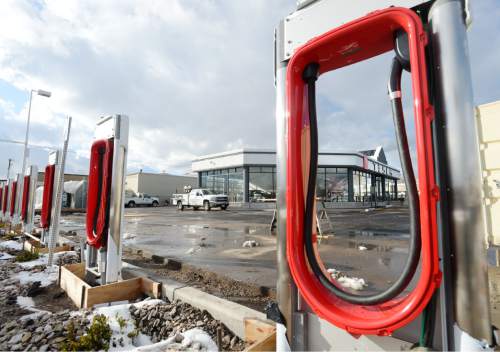This is an archived article that was published on sltrib.com in 2016, and information in the article may be outdated. It is provided only for personal research purposes and may not be reprinted.
Ogden • Electric vehicle ownership in northern Utah comes loaded with obstacles, but Rod Holtry is navigating them with a little help.
The biggest hurdle is finding enough electrons to get around. Holtry's own Nissan Leaf has an 85-mile range, which works fine running short errands. Longer distances, however, become complicated. That's why when businesses add charging stations for the public to use he does what he can to support them.
Case in point, when Weber State Credit Union installed a new charger at its main branch on Harrison Boulevard last month, Holtry made sure both his checking and business accounts were there.
"I had my business account at one bank, and my personal one at another and I was thinking of moving them to the same bank anyway, then I saw Weber State Credit Union had a charger," Holtry said. It's a seemingly arbitrary reason, he said, "but I figured I'd support them for putting a charger there."
Holtry mostly uses the PlugShare app to figure out where to recharge. Taking a look at its interactive map, the challenge of finding chargers becomes obvious. While there are loads of electric vehicle stations in Salt Lake City, very few public chargers have been installed around Ogden.
The PlugShare app shows about 12 commercial or public Tier 2 or higher EV charging stations in Weber and Davis counties, compared to the roughly 60 stations found in Salt Lake County alone.
"Ogden is noticeably denuded of stations," said Jeff Barrett, deputy director of the Governor's Office of Energy Development. "I think educating folks in your area is going to be key. I'm actually surprised at how few there are in Ogden."
Barrett's office has worked hard to educate Utah consumers about electric vehicles, or EVs. They've developed a calculator that compares the costs of owning a gas car versus an electric one. They've compiled a list of EV benefits. They've even tried to create their own map of EV stations, although it's not crowd sourced like PlugShare's app, so it's not as extensive.
Barrett's office has also worked hard to assemble funding for more EV stations, but they've almost exclusively gone to the state's capital, not outlying cities.
But Holtry said he sees businesses filling some of the local need. He also thinks they have plenty of incentives to do so.
"It's great for marketing," he said "And you've got a captive audience for at least half an hour."
Holtry works as a Realtor, so he drives around the Wasatch Front a lot. When his battery runs low after zipping around town, he usually stops at the Ken Garff Nissan Dealership on Riverdale Road.
The dealership has one of only two Tier 3 chargers in Utah north of Salt Lake (the other is at a dealership in North Salt Lake), and Tier 3 chargers are what EV drivers want because they're fast. It takes Holtry about 30 minutes to juice up his Leaf on a Tier 3. A Tier 2, by comparison, takes about 8 hours. Tier 1 means plugging into a regular outlet, and that can take 16 hours.
When Holtry uses the Ken Garff Tier 3, he said he waits at the dealership, taking advantage of its free soda and popcorn. He goes to other Nissan dealerships when he's in the Salt Lake area, too, and uses their Tier 3 chargers for free.
"I don't know how many times the average person stops at a dealership — probably every few years when they're looking at cars," he said. "But I go to a dealership once a week, sometimes more. And chances are, when we buy another car, it will be at a Nissan dealership."
That was at least part of the motivation for Weber State Credit Union's new Tier 2 charger, according to Community Engagement Director Roger Dickson.
"I think there's a good portion of our members, and in the market in general, who appreciated that environmentally friendly attitude and want to do business with companies that have a green focus," he said. "We could be better, not all our practices are perfect, but we're trying to do some of those things. I think people notice that and say 'yeah, I'd like to do business with you.'"
Especially in Utah, which struggles with poor air quality, there's an incentive for state officials to get more EVs on the road. They don't emit the chemicals that ultimately form particulate pollution in the winter and ozone in the summer.
"We know 50 to 55 percent of our particulate emissions in the (Salt Lake) Valley on an inversion day are related to vehicle emissions," Barrett said. "The next real opportunity to reduce emissions is electric vehicles. It's a huge opportunity, and one we have to really embrace."
State lawmakers removed a huge burden to businesses selling power to EV owners in 2013. Before, only a regulated utility like Rocky Mountain Power was allowed to sell electricity. Regulators weren't quite sure what to do with small-scale providers. But during the 2014 session, the Legislature removed those barriers.
"The main point is, no one would invest in a $20,000 charging station on their property if it's just an open wound bleeding free electrons," Barrett said. "A lot of businesses would only do it if they could recoup the cost by selling power."
But there are other barriers that remain for businesses wanting to install EV stations. First, there's the initial cost. A Tier 2 charger can cost $30,000 up front, and a Tier 3 can be double that.
Then there's the complicated way electric billing works. Rocky Mountain Power charges more during peak hours during the day — times when shoppers would likely be visiting businesses — and the more kilowatt hours a business sucks from the grid during peak, the more those kilowatt hours cost.
"So peak demand . could be driven to great heights by a fast-charging station," Barrett said. "So even if they're selling power at a premium, they could double the demand, get charged for that demand and lose money. It's a complicated calculus."
Barrett said one of his office's next steps will be to develop a resource for businesses thinking about installing EV stations, although he doesn't have a timeline. And while the Ogden area's charging stations are scant, they seem to be sufficient — there just aren't that many EVs out there yet. For the 2,500 EV owners in the state of Utah, there are around 200 charging stations.
"That's actually a pretty good number," Barrett said. "As soon as there's market pressure, I think businesses will start looking harder at it."
Ogden's Redevelopment Agency is also working to bring more stations to the city. It explored the idea of adding a few stations at a parking lot along 25th Street between Lincoln and Grant avenues last summer, through a partnership with the EVgo network. But the cost of upgrading the nearby transformers was too much for either the city or EVgo to swallow.
"I think it's still an option. I just think trying to figure out how to partner with the right company," said City Council Chair Marcia White. "I know Rocky Mountain Power is looking at some of those options as well, and you might see in the near future some conversations going on with them. It just depends on where they want to venture."
Weber State University is looking to add a public Tier 2 station to campus, too, although there's no word on when it will be ready.
In the meantime, Holtry is getting by with a little help from his friends. The PlugShare app also has an option for private homeowners to list their chargers for fellow EV owners in need. Holtry made it to Logan and back by connecting with a friendly homeowner in Providence. He's listed the charger in his own garage on the app, too.
"Everybody just does it for free, nobody charges anybody," he said. "It's a little bit of a community."









